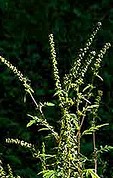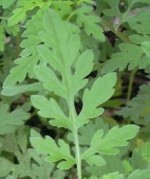 The bane of every hay fever sufferer, common ragweed is a summer annual native to North America and is found throughout the United States including Hawaii but not Alaska. It prefers full sun to partial shade with medium to dry conditions and is particularly common in disturbed areas such as gardens, cropland, abandon fields, vacant lots, and along roadsides, railroad tracks, and fence rows. It is valuable to birds and insects but has the ability to inhibit the growth of certain other plants.
The bane of every hay fever sufferer, common ragweed is a summer annual native to North America and is found throughout the United States including Hawaii but not Alaska. It prefers full sun to partial shade with medium to dry conditions and is particularly common in disturbed areas such as gardens, cropland, abandon fields, vacant lots, and along roadsides, railroad tracks, and fence rows. It is valuable to birds and insects but has the ability to inhibit the growth of certain other plants.
 Description: Seedlings emerge in the spring after the first warm rains. The seedlings have green stems often spotted with purple and cotyledons with purple undersides. Older plants have erect, branched, hairy stems that are green to pinkish red and grow up to four feet tall.
Description: Seedlings emerge in the spring after the first warm rains. The seedlings have green stems often spotted with purple and cotyledons with purple undersides. Older plants have erect, branched, hairy stems that are green to pinkish red and grow up to four feet tall.  The alternate or opposite leaves are once or twice pinnately compound and are about six inches long and four inches wide. Small green
The alternate or opposite leaves are once or twice pinnately compound and are about six inches long and four inches wide. Small green  bell-shaped flowers are produced in terminal racemes one to four inches long in late-summer to early fall. Male and female flowers are in separate heads on the same plant and the male flowers produced copious amounts of pollen that cause hay fever. The flowers gradually turn yellow to brown as they age and give way to small one seeded fruits (achenes) that are woody and resemble a queen’s crown. The seeds are wind disseminated and can remain viable in the soil for about five years. The root system is a fibrous tap root.
bell-shaped flowers are produced in terminal racemes one to four inches long in late-summer to early fall. Male and female flowers are in separate heads on the same plant and the male flowers produced copious amounts of pollen that cause hay fever. The flowers gradually turn yellow to brown as they age and give way to small one seeded fruits (achenes) that are woody and resemble a queen’s crown. The seeds are wind disseminated and can remain viable in the soil for about five years. The root system is a fibrous tap root.

 Control: Young plants are easy to hoe or hand-pull but mature plants may develop a woody base that snaps off when pulled leaving behind a nub that will grow into a new plant. Mulch can be used to inhibit the growth of new plants from seed. Herbicides containing a mixture 2,4-D and MCPP are effective on young plants actively growing in spring.
Control: Young plants are easy to hoe or hand-pull but mature plants may develop a woody base that snaps off when pulled leaving behind a nub that will grow into a new plant. Mulch can be used to inhibit the growth of new plants from seed. Herbicides containing a mixture 2,4-D and MCPP are effective on young plants actively growing in spring.